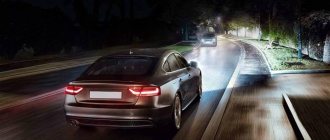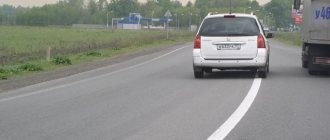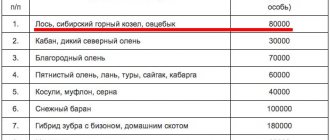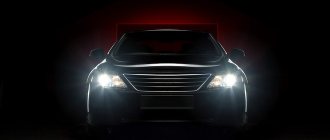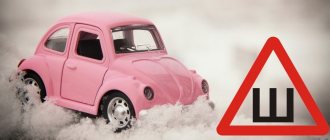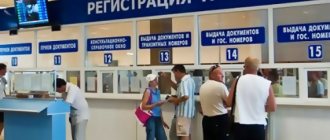Thorough knowledge of traffic rules is the responsibility of any car owner. The set of rules fully regulates the process of vehicle movement on the roads, thereby reducing the risk of accidents. In particular, the traffic rules quite clearly explain exactly where a stop should be made at an intersection. In this case, the driver’s actions will depend on the type of road intersection and the accompanying signs. At the same time, for non-compliance with traffic rules, administrative liability and punishment in the form of a fine are provided.
What is a crossroads
The essence of the concept of “intersection” is reflected in clause 1.2 of the code of traffic rules, regulated by Decree of the Government of the Russian Federation No. 1090 (dated October 23, 1993). This formulation denotes a specific place where roads branch, intersect or adjoin each other at the same level. A similar area is limited mentally by non-existent lines. The latter connect the rounded beginnings of roads located opposite each other, which are most distant from the center point of the intersection.
The concept does not include:
- departures from adjacent territorial areas;
- multi-level road junctions with bridges and overpasses.
In the above sections, the rules for moving through intersections, as well as stopping in front of them, do not apply.
In what cases and who is allowed to drive on the side of the road?
The Traffic Rules indicate a list of vehicles that are officially allowed to drive on the roadside:
- utility services;
- road services;
- vehicles that drive up to the facility to unload or load goods;
- cyclists who have reached the age of fourteen and in the absence of a specially designated lane for cyclists.
But even those who are allowed to drive on the side of the road must remember the culture and not interfere with pedestrians and other road users.
Features of stopping before crossing roads: tips for the driver
The rules for stopping before crossing roads are indicated in clause 6, as well as clause 13 of the traffic rules. In this case, the driver’s actions depend on the type of intersection. There are 2 types in total - regulated and unregulated.
At the same time, despite a fairly clear statement of the requirements for traffic on the roadway, car owners often encounter difficulties. Especially stopping before an intersection and generally moving around it is difficult for novice drivers.
In order not to break the rules and successfully drive through such a section, while slowing down in the right place, you will need to act as follows:
- determine the travel option - entering or exiting the intersection;
- change lanes;
- find out the type of intersection you are crossing - from here it will become clear where exactly you should stop;
- follow the signs placed and depicted on the road surface.
Carrying out the listed actions, and in general, knowledge of traffic regulations will help you comply with safety standards and prevent emergency situations.
Stopping and parking on the lawn
Every motorist should know that issuing a fine for this offense is not carried out by the State Traffic Inspectorate, but by the city improvement inspectorate.
Of course, the driver cannot always fully assess whether the stopping area is a lawn. It is especially difficult not to break the rules in winter, when behind a layer of snow it is not clear whether the asphalt is finished. Therefore, most often lawns are fenced with special borders.
The driver will be required to pay a fine. How many stops in the wrong place a driver makes, so many orders can come. The amount of the fine depends on the damage caused to the lawn, as well as the status of the owner. For example, a fine of 3 thousand rubles may be issued to an individual. A legal entity will pay more. The maximum fine is 500 thousand rubles.
Rules for stopping at a signalized intersection
According to clause 13.3 of the Rules, a controlled intersection is understood as an area where the priority of movement is determined by a traffic light or by the direction of a traffic controller. Accordingly, the stop in this case is carried out by a prohibiting command or signal.
When choosing a place, you should be guided by clause 6.13 of the traffic rules. The rule states that a stop line at a traffic light means you need to brake strictly in front of it. The corresponding sign is indicated by number 6.16. In practice, it looks like a sign with an image of the word “STOP” .
Options for placing a sign on the road surface:
- to the right of the roadway (usually at the traffic light itself);
- over the road;
- over each traffic lane.
Also, the stop line can take the form of a marking. In this case, you need to brake directly in front of it.
If there are both signs on the road, then you should stop in front of the “STOP” sign. This is due to the fact that road signs take precedence over markings.
As for where and how to stop at a traffic light at a controlled intersection, if there are no additional signs, then in such a situation you need to brake in front of the roadway. In this case, you must not interfere with pedestrian traffic.
In practice, there are 2 options for stopping if there is no sign 6.16:
- in front of a traffic light, if there is no crossing for pedestrians;
- before the zebra crossing, if there is one.
If there are no pedestrian markings, but people are crossing the area, then you need to stop immediately in front of it. It is forbidden to interfere with citizens and drive past traffic lights.
Additionally, it is worth considering clause 13.7 of the Rules. It states that a car owner who has entered a road intersection when there is a traffic signal allowing such action must leave the area in the chosen direction. Movement in this case does not depend on the commands of the traffic light located at the exit from this zone. But if there are stop lines on the site located in front of traffic lights along the vector of the vehicle’s movement, then its owner is obliged to act in accordance with the commands of each signaling device.
Dear reader! Didn't receive an answer to your question? Our expert lawyers work for you. It's absolutely free!
- Moscow ext 152
- St. Petersburg ext 152
- All regions ext 132 (Toll free)
Contradictory fines when stopping on the side of the road
The Code of Administrative Offenses contains comprehensive information about in what situations and in what amounts various fines are used. However, there are certain cases when it is impossible to apply a fine, as there are controversial issues.
The driver can stop on the side of the road if this does not pose a danger to other people and does not create an obstacle for pedestrians. But the traffic police inspector may consider such a situation as a violation.
Driving on the side of the road poses a danger not only to others, but also to roadside drivers themselves. Watch the video:
For example, a car owner stops the car on the side of the road in accordance with all the rules, without interfering with other drivers or pedestrians.
How to appeal a fine for an administrative violation? Read the link.
After he starts driving again, he is stopped by a traffic police inspector. He writes a fine for driving on the side of the road, because in fact the driver was moving along it.
There is a contradiction, since stopping on the side of the road is allowed, but moving is prohibited. It is almost impossible to prove any truth, so the driver can only challenge this situation by presenting evidence that the stop was carried out in accordance with all the rules.
But usually you still have to pay the fine. How to pay a fine without a fee? See here.
This decision by the authorities is aimed at not impeding traffic on major highways and roads.
By introducing a fine, it is allowed:
- protect drivers from having to go to the side of the road;
- reduce the number of accidents;
- prevent injuries to pedestrians and cyclists;
- resolve parking issues.
Thus, driving on the side of the road is a serious offense that is punishable by a significant fine and the possibility of losing the car owner’s license.
Therefore, every motorist must follow the rules, drive with caution and not create obstacles or difficulties for other people.
Stopping at an unregulated intersection
If there is no traffic controller or traffic light at the intersection of roads, and if it is turned off or flashing yellow, then the area is considered unregulated.
The variety includes 2 more subtypes:
- Equivalent intersection. Signs: there is no traffic controller or traffic light, intersecting roads have the same surface, no priority signs. A site is recognized as equivalent only if the specified conditions are simultaneously met. Additionally, sign 1.6 may be placed as a designation.
- Uneven intersection. In this case, one of the intersecting roads must be the main one. It is indicated by signs 2.1, 5.1, 2.3.1–2.3.7. Or it can be a road with a hard surface (asphalt, stone), while secondary areas should be covered with soil (sand, earth). The road is also considered the main one in relation to exits from the adjacent territory.
Stopping in front of such areas is regulated by the presence of sign 2.5. The sign “Driving without stopping is prohibited” is usually placed at an unregulated intersection of unequal roads.
2.5 indicates the prohibition of movement without stopping in front of the stop line or in front of the edge of the roadway. In this case, the car owner is obliged to give way to cars moving along the road part he is crossing, or along the main road, if sign 8.13 is present.
The choice of where to brake a car if there is a 2.5 indicator should be as follows:
- in front of the stop line, if there is one;
- before crossing highways if the line is not marked.
In fact, it turns out that stopping at an unregulated intersection of roads is mandatory only if there are signs of inequality, and there is a sign 2.5 on the section.
Characteristics of the “No Stopping” sign
A road sign prohibiting vehicle idling on a specific section of the highway is a blue circle with a red frame, through the center of which two equal stripes pass crosswise. In these rules, such a sign is marked with serial number 3.27, but the length of its effect directly depends on the accompanying signs located under it, as well as the markings applied.
If the listed symbols are absent, then standard restrictions will apply to the “No Stopping” sign:
- Until the first intersection with a traffic light or marked with a stop line;
- To the pointer that removes all limits (a white circle with a black frame, inside of which five equal stripes stretch diagonally);
- To the sign indicating the boundaries of the settlement (taken into account only when leaving the city).
The sign itself imposes a ban on stopping the movement of vehicles in the designated area, even for less than 1 minute (except for the exceptions specified in the traffic rules). But long-term parking under it may even result in the driver having his car towed to a parking lot.
Sign area
Previously, we discussed that the duration of the road sign 3.27 directly depends on the accompanying markings and signs located under it. But in order to make it clearer for motorists in which case they will be fined for standing behind a “No Stopping” sign, we will look at the most common examples of combinations that set individual restrictions on it. These include:
- A sign with an oblong arrow pointing upward. If there is such a mark, the driver has the right to stop driving before the road sign, but not after it;
- An emblem with an arrow pointing downwards. With such a sign, a motorist can stop his vehicle only outside the sign;
- A plate with a reverse arrow, the edges of which are directed in two opposite directions. It is strictly forbidden to stop either before or after sign 3.27;
- A sign with an image of a specific type of vehicle (motorcycle, passenger car, truck, bus, etc.), or numbers indicating the length of the sign.
Yellow markings along the side of the road can also limit the area of influence of sign 3.27. Although in practice it raises many questions when challenging traffic police protocols, due to its non-compliance with GOST.
Is stopping at a road intersection allowed?
If you need to stop on intersecting road sections, the main thing is not to go to the intersection itself, or to the pedestrian zebra crossing. This is prohibited by clause 12.4 of the traffic rules. You should brake more than 5 m before the road you are crossing.
The exception includes the sides opposite the side passages of three-way intersections. In particular, if they have a dividing strip or a continuous marking line.
According to clause 12.5 of the Rules, parking of vehicles at road intersections is also not allowed. In this case, a forced stop falls into the category of exceptions. For example, due to a malfunction of the car, unfavorable condition of the driver or passenger, or when an obstacle appears on the roadway.
However, stopping behind the intersection is permitted. After leaving the intersection, parking the car is allowed in accordance with the general requirements and parking rules (clause 12 of the traffic rules).
Amounts of fines for violation
Depending on the circumstances that entailed ignoring road sign 3.27 or other signs and markings prohibiting stopping the vehicle, the driver may face the following sanctions prescribed by the Code of Administrative Offenses of the Russian Federation:
| Description of the offense | Article of the Administrative Code | Type of responsibility |
| Downtime under sign 3.27 “No parking” | 12.16 | Warning or fine in the amount of 500 to 2500 rubles |
| Stopping traffic at a pedestrian crossing | 12.19 | Financial recovery in the amount of up to 1000 rubles. |
| Parking on the sidewalk or in green areas | 12.19 | Fine in the amount of 1000 to 3000 rubles |
| Downtime at a place designated for public transport stops | 12.19 | Material penalty in the amount of 2000 rubles. |
| Stopping movement under sign 3.28 “Stopping is prohibited” | 12.16 | Warning or fine in the amount of 500 rubles |
| Downtime on tram tracks or at a railway crossing | 12.18 | Material recovery in the amount of 1000 to 3000 rubles. |
It is important to know! We found out what fine an ordinary driver who has nothing to do with exceptions faces for a “No Stopping” sign. But if the violator pays the traffic police report within 20 days from the date of its preparation, then a 50% discount will be applied to the amount issued.
Amount of fine for driving on the side of the road
Driving on the side of the road is classified as an administrative offense and is usually punishable by a fine, the amount of which depends on several nuances.
- If you drove and overtook on the right shoulder, then your actions fall under the clause of violation of maneuvering and overtaking rules and, according to Article 12.15, paragraph 1 of the Code of Administrative Offenses of the Russian Federation, face a fine of 1,500 rubles.
- Overtaking by driving to the side of the road on the left side is punished more severely, which is not surprising - such a maneuver involves driving in the oncoming lane and inherently leads to a violation of two rules at once. In this case, all prohibitions related to driving in the oncoming lane apply. Violation can be punished either by a fine, the total amount of which is 5,000 rubles, or by deprivation of rights for a period of 4 to 6 months. Repeated violation will result in deprivation of rights for up to one year.
It should be clarified that it will not work to get away with a smaller fine by arguing that driving into the oncoming lane by avoiding an obstacle, since a traffic jam is not such an obstacle. Compliance with the rules is monitored not only by traffic police inspectors, but also by photo and video recording equipment. The latter, due to their automaticity, are inexorable - a fine can be issued even if your car ended up on the side of the road for completely legal reasons.
Why can't you drive on the side of the road?
Even initially, when studying at a driving school, each future driver is explained clause 9.9 of the Road Traffic Rules, according to which driving on the side of the road is prohibited, since such movement creates a threat to pedestrians and cyclists who are on the side of the road at the time.
And driving instructors teach us that driving on the side of the road is fraught with the fact that fragments of headlights or car parts, small nails or screws may remain on it - all this can damage the wheels of a car maneuvering on the side of the road. In addition, dust rises and inconvenience is created for other motorists; when returning to the road, an emergency situation will be created.
And since the side of the road is not intended for the movement of vehicles, when driving along it, when avoiding a traffic jam, the driver runs the risk of getting into a “skid” situation.
The wheels of the car will not have traction with the surface and there is a great danger of driving off the side of the road both towards other cars, which can cause damage to other people’s property, and driving into a ditch, when not only the car, but also the people in it can suffer.
Is it possible to challenge a fine and how to do it?
Regardless of whether the driver was right or guilty and actually avoided the traffic jam on the side of the road, in both cases the motorist has the right and will have to go to court within 10 calendar days to challenge the fine imposed on him. And in this situation, it will be necessary to take all measures to prove that he did not drive along the side of the road.
To do this, it will be possible to attract witnesses or video from a dashcam camera as evidence, and you can also seek professional help from lawyers specializing in such disputes - auto lawyers.
But if you do not have the opportunity to pay for the services of lawyers, then, after receiving a ruling on an administrative violation, you can do the following on your own:
- within ten calendar days it will be determined to which body you want to file a complaint against this resolution (this may be a higher authority above the one who signed the resolution or a court);
- draw up the text of the complaint, in which you indicate all the circumstances of what happened, as well as with reference to the norms of the current legislation (an example text of the complaint can be found on the Internet by entering the appropriate query in a search engine);
- be sure to attach all available evidence (video from a DVR, testimony of eyewitnesses, a petition to request video from cameras of nearby objects, etc.);
- if the complaint is considered in court, he will appear at the court hearing and insist that he is right.
However, there are situations when the driver actually saved time and, breaking the rules, drove around the traffic jam on the side of the road. To save money, the driver tries to circumvent the law and present the situation as if he was only driving around an obstacle on the side of the road. But the traffic rules provide for the definition of “obstacle” and a traffic jam is definitely not an obstacle.
According to traffic police statistics, this tightening of restrictions on driving on the side of the road has borne fruit, and there are fewer violators, as before, with seat belts - almost the entire country now drives with seat belts fastened, thanks to the work of traffic police officers and preventive measures in the form of advertising. Now only a few drivers drive without wearing a seat belt.
Thus, in order to avoid fines or, in case of repeated violations, deprivation of a driver’s license, drivers should be patient, follow the rules of the road, and, in addition, respect each other and not deliberately create emergency situations, which, unfortunately, occur on our roads and so too much.
Didn't find the answer to your question? Find out how to solve exactly your problem - call right now: +7 (Moscow) +7 (812) 309-53-42 (St. Petersburg) It's fast and free!
Free online consultation with a car lawyer
Didn't find the answer to your question? Find out how to solve exactly your problem - call right now: +7 (Moscow) +7 (812) 309-53-42 (St. Petersburg) It's fast and free!
Questionable points in the rules and imposition of fines
Unfortunately, traffic rules are not perfect. Despite the fact that they clearly indicate the amount of fines and the procedure for collecting them, technical issues leave room for interpretation, which in some cases works against the driver.
A simple example: a driver, on completely legal grounds and within the framework of the rules, pulls onto the side of the road for the purpose of stopping, and when he drives back onto the roadway, he attracts the attention of a traffic police inspector. And the inspector, also on completely legal grounds, brings charges of violating traffic rules. This happens infrequently, and, as a rule, inspectors prefer not to bother, but such a situation is possible, and it is worth knowing about it.
Standing in traffic jams, of course, is not very pleasant, and sometimes you want to take a shortcut, but this is not a reason to break traffic rules. This can lead to a not very pleasant outcome: loss of money, rights, and even an accident. And if you don’t mind your money, then you should think about other motorists and pedestrians for whom driving along the side of the road can cause a lot of trouble.
